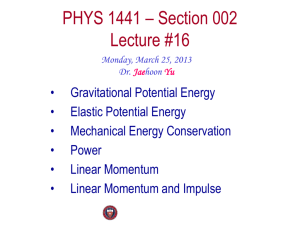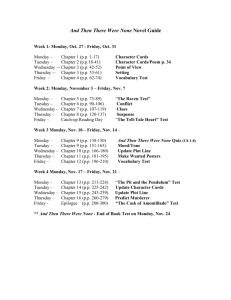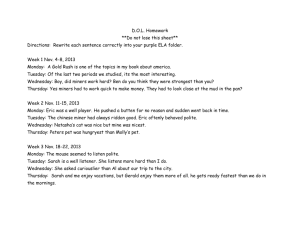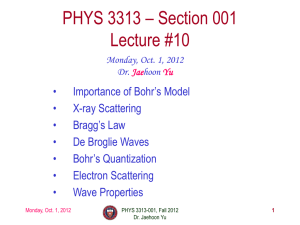phys3313-fall12-111912
advertisement
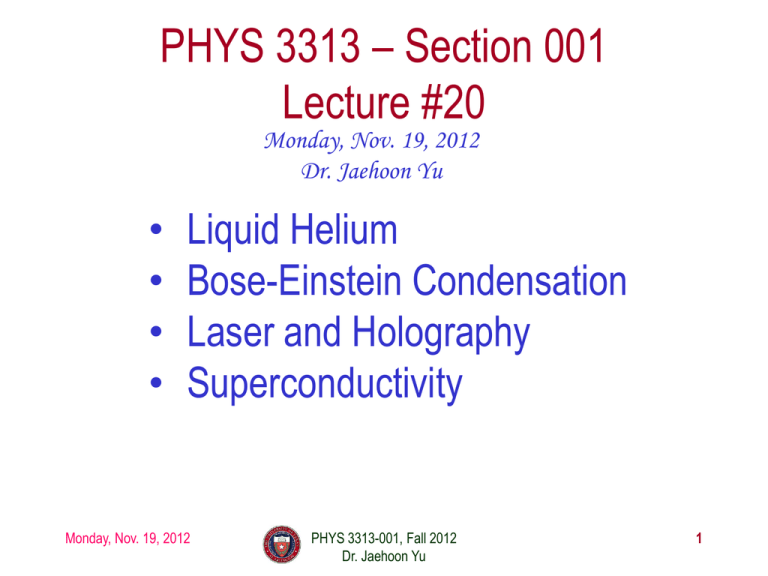
PHYS 3313 – Section 001 Lecture #20 Monday, Nov. 19, 2012 Dr. Jaehoon Yu • • • • Liquid Helium Bose-Einstein Condensation Laser and Holography Superconductivity Monday, Nov. 19, 2012 PHYS 3313-001, Fall 2012 Dr. Jaehoon Yu 1 Announcements • Remember the deadline for your research paper, Monday, Nov. 26!! • Your presentations are in classes on Dec. 3 and Dec. 5 – All presentation ppt files must be sent to me by 8pm Sunday, Dec. 2 • Final exam is 11am – 1:30pm, Monday, Dec. 10 • Reading assignments – CH10.1, 10.3 and 10.4 • • • • No regular colloquium this week Quiz Monday, Nov. 26 No class this Wednesday! Happy Thanksgiving! Class feedback today!! Monday, Nov. 19, 2012 PHYS 3313-001, Fall 2012 Dr. Jaehoon Yu 2 Research Project Report 1. Must contain the following at the minimum – Original theory or Original observation – Experimental proofs or Theoretical prediction + subsequent experimental proofs – Importance and the impact of the theory/experiment – Conclusions 2. Each member of the group writes a 10 (max) page report, including figures – 10% of the total grade – Can share the theme and facts but you must write your own! – Text of the report must NOT be a copy – Due Mon., Nov. 26, 2012 Monday, Nov. 19, 2012 PHYS 3313-001, Fall 2012 Dr. Jaehoon Yu 3 • Research Presentations Each of the 10 research groups makes a 10min presentation – – – 8min presentation + 2min Q&A All presentations must be in power point I must receive all final presentation files by 8pm, Sunday, Dec. 2 • – • The representative of the group makes the presentation followed by all group members’ participation in the Q&A session Date and time: – • No changes are allowed afterward In class Monday, Dec. 3 or in class Wednesday, Dec. 5 Important metrics – Contents of the presentation: 60% • • – – – – – Inclusion of all important points as mentioned in the report The quality of the research and making the right points Quality of the presentation itself: 15% Presentation manner: 10% Q&A handling: 10% Staying in the allotted presentation time: 5% Judging participation and sincerity: 5% Monday, Nov. 19, 2012 PHYS 3313-001, Fall 2012 Dr. Jaehoon Yu 4 Liquid Helium • Has the lowest boiling point of any element (4.2 K at 1 atmosphere pressure) and has no solid phase at normal pressure • Helium is so light and has high speed and so escapes out side of the Earth atmosphere Must be captured from underground Monday, Nov. 19, 2012 PHYS 3313-001, Fall 2012 Dr. Jaehoon Yu 5 Liquid Helium The specific heat of liquid helium as a function of temperature •The temperature at about 2.17 K is referred to as the critical temperature (Tc), transition temperature, or lambda point. •As the temperature is reduced from 4.2 K toward the lambda point, the liquid boils vigorously. At 2.17 K the boiling suddenly stops. •What happens at 2.17 K is a transition from the normal phase to the superfluid phase. Monday, Nov. 19, 2012 PHYS 3313-001, Fall 2012 Dr. Jaehoon Yu 6 He Transition to Superfluid State T>Tc T<Tc Vessel with very fine holes that do not allow passage of normal liquid See the liquid here Boiling surface Calm surface below 2.17K Monday, Nov. 19, 2012 PHYS 3313-001, Fall 2012 Dr. Jaehoon Yu 7 Liquid Helium • The rate of flow increases dramatically as the temperature is reduced because the superfluid has a low viscosity. • Creeping film – formed when the viscosity is very low • But when the viscosity is measured through the drag on a metal surface, He behaves like a normal fluid Contradiction!! Monday, Nov. 19, 2012 PHYS 3313-001, Fall 2012 Dr. Jaehoon Yu 8 Liquid Helium Fritz London claimed (1938) that liquid helium below the lambda point is a mixture of superfluid and normal fluid. As the temperature approaches absolute zero, the superfluid approaches 100% superfluid. The fraction of helium atoms in the superfluid state: æTö F = 1- ç ÷ è Tc ø 32 Superfluid liquid helium (4He) is referred to as a BoseEinstein condensation. 4He is a boson thus it is not subject to the Pauli exclusion principle all particles are in the same quantum state Monday, Nov. 19, 2012 PHYS 3313-001, Fall 2012 Dr. Jaehoon Yu 9 Liquid Helium Critical Temp. • Such a BE condensation process is not possible with fermions because fermions must “stack up” into their energy states, no more than two per energy state. • 3He, an isotope of 4He, is a fermion and superfluid mechanism is radically different than the Bose-Einstein condensation. • Use the fermions’ density of states function and substituting for the -3 2 2 constant EF yields pæ h ö gFD ( E ) = 2 çè 8mL2 ÷ø E1 2 • Bosons do not obey the Pauli principle, therefore the density of states should be less by a factor of 2. 1 æ 8mL2 ö p gBE ( E ) = gFD ( E ) = ç 2 ÷ 2 4è h ø Monday, Nov. 19, 2012 32 3 2p V 32 12 2 p L 32 12 12 = 2m ) E E = 3 ( 2m ) E 3 ( h h PHYS 3313-001, Fall 2012 Dr. Jaehoon Yu 10 Liquid Helium Critical Temp. m is the mass of a helium atom and V is the volume in consideration The number distribution n(E) is now 2p V 1 32 12 n ( E ) = gBE ( E ) FBE = 3 ( 2m ) E h BBE eE kT -1 In a collection of N helium atoms the normalization condition is N=ò ¥ 0 2p V E1 2 32 ¥ dE n ( E )dE =ò gBE ( E ) FBE dE = 3 ( 2m ) ò0 E kT 0 h BBE e -1 ¥ Substituting u = E / kT, kTu ) 2p V ( 32 2p V u1 2 32 ¥ kTdu = 3 ( 2mkT ) ò N = 3 ( 2m ) ò0 du u u 0 B e -1 h BBE e -1 h BE ¥ Monday, Nov. 19, 2012 12 PHYS 3313-001, Fall 2012 Dr. Jaehoon Yu 11 Liquid Helium Critical Temp. • Use minimum value of BBE = 1; this result corresponds to the maximum value of N. 12 ¥ 2p V u 32 2p V N £ 3 ( 2mkT ) ò u du = 3 ( 2mkT )3 2 ( 2.315 ) 0 e -1 h h • Rearrange this, ù h é N T³ ê ú 2mk ë 2p V ( 2.315 ) û 2 32 Using the normal liquid He number density (N/V), the result is T ≥ 3.06 K. • The value 3.06 K is an estimate of Tc. Monday, Nov. 19, 2012 PHYS 3313-001, Fall 2012 Dr. Jaehoon Yu 12 Bose-Einstein Condensation in Gases • BE condensation in liquid has been accomplished but gas condensation state hadn’t been till 1995 • The strong Coulomb interactions among gas particles made it difficult to obtain the low temperatures and high densities needed to produce the BE condensate. • Finally success was achieved by E. Cornell and C. Weiman in Boulder, CO, with Rb (at 20nK) and W. Kettle at MIT on Sodium (at 20 K) Awarded of Nobel prize in 2001 • The procedure – Laser cool their gas of 87Rb atoms to about 1 mK. – Used a magnetic trap to cool the gas to about 20 nK, driving away atoms with higher speeds and keeping only the low speed ones – At about 170 nK, Rb gas went through a transition, resulting in very cold and dense state of gas • Possible application of BEC is an atom laser but it will take long time.. Monday, Nov. 19, 2012 PHYS 3313-001, Fall 2012 Dr. Jaehoon Yu 13 Stimulated Emission and Lasers Spontaneous emission: A molecule in an excited state will decay to a lower energy state and emit a photon, without any stimulus from the outside. Due to the uncertainty principle, the best we can do is to calculate the probability that a spontaneous transition will occur. And the phases of the photons emitted from this process are random If a spectral line has a width ΔE, then a lower-bound estimate of the lifetime is Δt = ħ / (2 ΔE). Monday, Nov. 19, 2012 PHYS 3313-001, Fall 2012 Dr. Jaehoon Yu 14 Stimulated Emission and Lasers Stimulated emission: A photon incident upon a molecule in an excited state causes the unstable system to decay to a lower state. • The photon emitted tends to have the same phase and direction as the stimulated radiation. • If the incoming photon has the same energy as the emitted photon: • The result is two photons of the same • • wavelength and phase traveling in the same direction. Because the incoming photon just triggers emission of the second photon. These two photons are said to be coherent! • Einstein explained this stimulated emission in his 1917 paper “On the Quantum Theory of Radiation Monday, Nov. 19, 2012 PHYS 3313-001, Fall 2012 Dr. Jaehoon Yu 15 Stimulated Emission and Lasers • Laser stands for “light amplification by the stimulated emission of radiation” – The first working laser was by Theodore H. Maiman in 1960 • Masers: Microwaves are used instead of visible light. – The first working maser was by C.H. Townse in 1954 helium-neon laser Monday, Nov. 19, 2012 PHYS 3313-001, Fall 2012 Dr. Jaehoon Yu 16 Stimulated Emission and Lasers • The body of the laser is a closed tube, filled with about a 9/1 ratio of helium and neon. • Photons bouncing back and forth between two mirrors are used to stimulate the transitions in neon. • Photons produced by stimulated emission will be coherent, and the photons that escape through the silvered mirror will be a coherent beam. How are atoms put into the excited state? We cannot rely on the photons in the tube; if we did: 1) Any photon produced by stimulated emission would have to be “used up” to excite another atom. 2) There may be nothing to prevent spontaneous emission from atoms in the excited state. The beam would not be coherent. Monday, Nov. 19, 2012 PHYS 3313-001, Fall 2012 Dr. Jaehoon Yu 17 Stimulated Emission and Lasers Use a multilevel atomic system to see those problems. • Three-level system 1) Atoms in the ground state are pumped to a higher state by some external energy source (power supply) 2) The atom decays quickly from E3 to E2. The spontaneous transition from E2 to E1 is forbidden by a Δℓ = ±1 selection rule. E2 is said to be metastable. 3) Population inversion: more atoms are in the metastable than in the ground state Monday, Nov. 19, 2012 PHYS 3313-001, Fall 2012 Dr. Jaehoon Yu 18 Stimulated Emission and Lasers • After an atom has been returned to the ground state from E2, we want the external power supply to return it immediately to E3, but it may take some time for this to happen. • A photon with energy E2 − E1 can be absorbed by the atom resulting a much weaker beam • This is undesirable because the absorbed photon is unavailable for stimulating another transition. • A four level system can help avoiding this system Monday, Nov. 19, 2012 PHYS 3313-001, Fall 2012 Dr. Jaehoon Yu 19 Stimulated Emission and Lasers • Four-level system 1) Atoms are pumped from the ground state to E4. They decay quickly to the metastable state E3. The stimulated emission takes atoms from E3 to E2. The spontaneous transition from E2 to E1 is not forbidden, so E2 will not exist long enough for a photon to be kicked from E2 to E3. Lasing process can proceed efficiently. 2) 3) 4) Monday, Nov. 19, 2012 PHYS 3313-001, Fall 2012 Dr. Jaehoon Yu 20 Stimulated Emission and Lasers • The red helium-neon laser uses transitions between energy levels in both helium and neon via their collisions Monday, Nov. 19, 2012 PHYS 3313-001, Fall 2012 Dr. Jaehoon Yu 21 Tunable & Free Electron Lasers Tunable laser: • The emitted radiation wavelength can be adjusted as wide as 200 nm adjusting the mixture of organic dyes • Semi conductor lasers are replacing dye lasers. Free-electron laser: Monday, Nov. 19, 2012 PHYS 3313-001, Fall 2012 Dr. Jaehoon Yu 22 Free Electron Lasers • This laser relies on charged particles. • A series of magnets called wigglers is used to accelerate a beam of electrons. • Free electrons are not tied to atoms; they aren’t dependent upon atomic energy levels and can be tuned to wavelengths well into the UV part of the spectrum. • Went down to 0.15nm wavelength at SLAC light source in 2009 Monday, Nov. 19, 2012 PHYS 3313-001, Fall 2012 Dr. Jaehoon Yu 23 Scientific Applications of Lasers • An extremely coherent and nondivergent beam is used in making precise determination of large and small distances. – Precise determination of the speed of light resulted from precision laser measurement redefinition of 1m – Precise (to 10cm) determination of the distance between the Earth and the moon • Pulsed lasers are used in thin-film deposition to study the electronic properties of different materials. • The use of lasers in fusion research for containing enough nuclei in a confined space for fusion to occur – Inertial confinement: A pellet of deuterium and tritium would be induced into fusion by an intense burst of laser light coming simultaneously from many directions. Monday, Nov. 19, 2012 PHYS 3313-001, Fall 2012 Dr. Jaehoon Yu 24 Holography • Consider laser light emitted by a reference source R. • The light through a combination of mirrors and lenses can be made to strike both a photographic plate and an object O. • The laser light is coherent; the image on the film will be an interference pattern. Monday, Nov. 19, 2012 PHYS 3313-001, Fall 2012 Dr. Jaehoon Yu 25 Holography • After exposure this interference pattern is a hologram, and when the hologram is illuminated from the other side, a real image of O is formed. • If the lenses and mirrors are properly situated, light from virtually every part of the object will strike every part of the film. Each portion of the film contains enough information to reproduce the whole object in 3D Monday, Nov. 19, 2012 PHYS 3313-001, Fall 2012 Dr. Jaehoon Yu 26 Holography Transmission hologram: The reference beam is on the same side of the film as the object and the illuminating beam is on the opposite side. Reflection hologram: Reverse the positions of the reference and illuminating beam. The result will be a white light hologram in which the different colors contained in white light provide the colors seen in the image. Interferometry: Two holograms of the same object produced at different times can be used to detect motion, growth or imperfections that could not otherwise be seen. Monday, Nov. 19, 2012 PHYS 3313-001, Fall 2012 Dr. Jaehoon Yu 27 Other Laser Applications • Used in surgery to make precise incisions – Ex: eye operations • We see in everyday life such as the scanning devices used by supermarkets and other retailers – Ex. Bar code of packaged product CD and DVD players • Laser light is directed toward disk tracks that contain encoded information. The reflected light is then sampled and turned into electronic signals that produce a digital output. Monday, Nov. 19, 2012 PHYS 3313-001, Fall 2012 Dr. Jaehoon Yu 28 Superconductivity • Superconductivity is characterized by the absence of electrical resistance and the expulsion of magnetic flux from the superconductor and was discovered 100 yrs ago It is characterized by two macroscopic features: • Zero resistivity – First discovered in 1911 by Onnes who achieved temperatures approaching 1 K with liquid helium. – In a superconductor the resistivity drops abruptly to zero at critical (or transition) temperature Tc. – Superconducting behavior tends to be similar within a given column of the periodic table. – In 1956 – 1958, British physicists led by S.C. Collins established a current in a superconducting ring without power source Monday, Nov. 19, 2012 PHYS 3313-001, Fall 2012 Dr. Jaehoon Yu 29 Superconductivity – Zero Resistivity Tc Monday, Nov. 19, 2012 PHYS 3313-001, Fall 2012 Dr. Jaehoon Yu 30 Superconductivity –Meissner Effect • • • • The complete expulsion of magnetic flux from within a superconductor by generating a screening current discovered in 1933 by W. Meissner and R. Oschenfeld The Meissner effect works only to the point where the critical field Bc is exceeded, and the superconductivity is lost until the magnetic field is reduced to below Bc. The critical field varies with temperature. To use a superconducting wire to carry current without resistance, there will be a limit (critical current) to the current that can be used. Monday, Nov. 19, 2012 PHYS 3313-001, Fall 2012 Dr. Jaehoon Yu 31 Type I and Type II Superconductors There is a lower critical field, Bc1 and an upper critical field, Bc2. Type II: Below Bc1 and above Bc2. Behave in the same manner Type I: Below and above Bc Monday, Nov. 19, 2012 PHYS 3313-001, Fall 2012 Dr. Jaehoon Yu 32 Type I and Type II Superconductors • Between Bc1 and Bc2 (vortex state), there is a partial penetration of magnetic flux although the zero resistivity is not lost. Lenz’s law: • A phenomenon from classical physics • A changing magnetic flux generates a current in a conductor in such way that the current produced will oppose the change in the original magnetic flux. Monday, Nov. 19, 2012 PHYS 3313-001, Fall 2012 Dr. Jaehoon Yu 33

